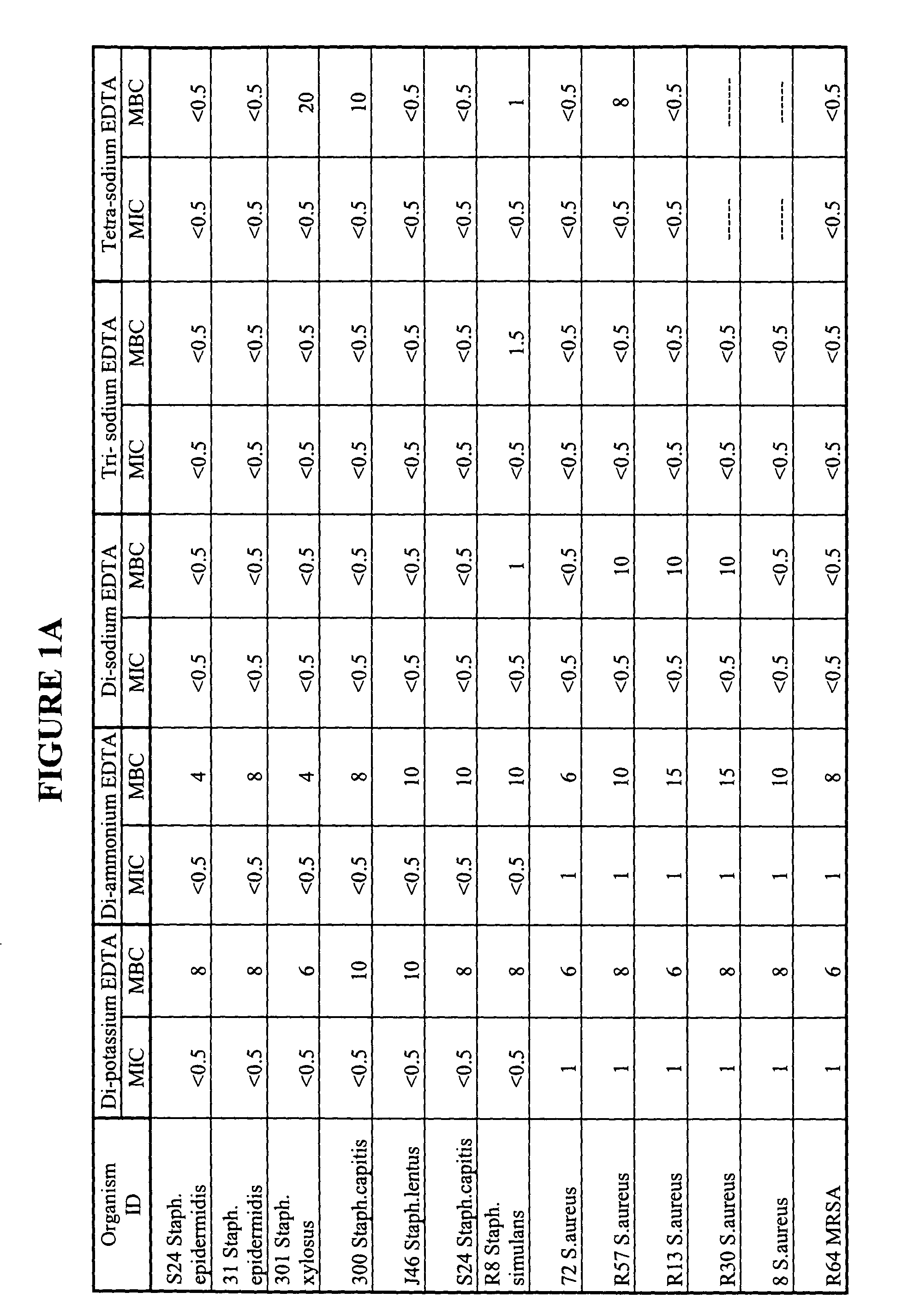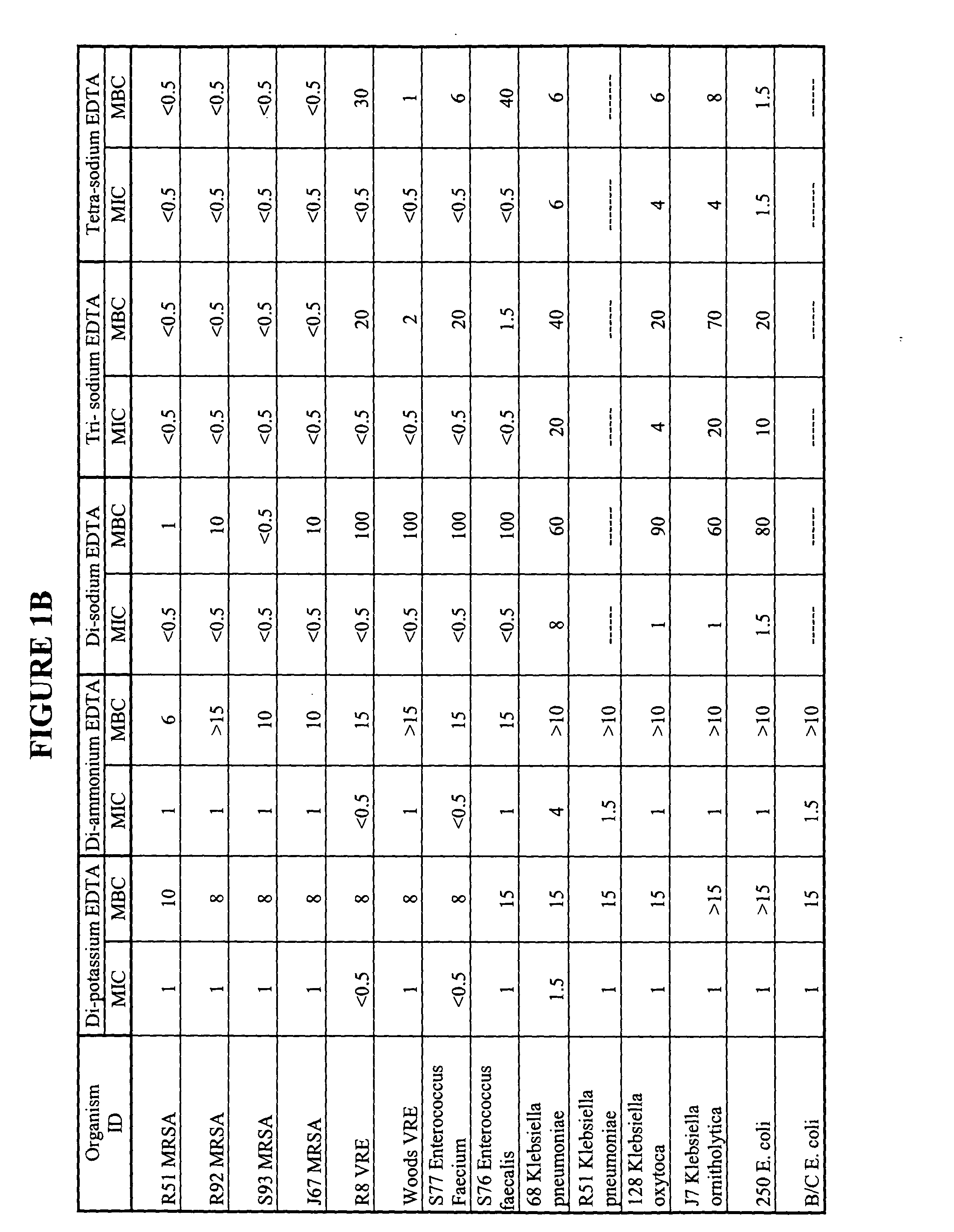Antiseptic compositions, methods and systems
a technology of compositions and antibacterial agents, applied in the field of antibacterial compositions, methods and, can solve the problems of increasing the cost of antibacterial agents, reducing their efficacy, and significant problems, and achieve the effect of reducing or substantially eliminating microbial populations
- Summary
- Abstract
- Description
- Claims
- Application Information
AI Technical Summary
Benefits of technology
Problems solved by technology
Method used
Image
Examples
example 1
Minimum Inhibitory Concentration (MIC) and Minimum Bactericidal Concentration (MBC) Data for Organisms Against Different Formulations of EDTA, Using the Agar Dilution Method
[0062]The minimum inhibitory concentrations (MIC) and minimum bactericidal concentrations (MBC) for various gram-positive and gram-negative bacterial and yeast organisms were established for several different formations of EDTA. The MICs and MBCs for various organisms were also tested in combinations of EDTA salt(s). The agar dilution method (protocol described below) was used.
[0063]The gram-positive and gram-negative bacterial organisms were isolated from human patients having catheter-related infections to ensure that the bacterial stains were actively pathogenic and were of the type common in human catheter-related bacterial infections. The yeast organisms were collected from patients having serious septicemia infections. The organisms were catalogued and maintained in the laboratory of Peter Kite at the Unive...
example 2
Minimum Biofilm Eradication Concentration (MBEC) Data for Organisms Against Tetra-Sodium EDTA, Using the Modified Calgary Device Method
[0083]Biofilm formation is an important factor in bacterial contamination. An effective antiseptic composition preferably has the ability to reduce the proliferation of biofilm, or prevent or inhibit the formation of biofilms. We therefore tested our candidate tetra-sodium EDTA antiseptic solution to determine whether it could prevent or inhibit the formation of biofilms. The minimum biofilm eradication concentration (MBEC) for various organisms against tetra-sodium EDTA was established using a modified Calgary device method. The Calgary method is described in the CANADIAN JOURNAL OF VETERINARY RESEARCH, 66:86-92 (2002) and in U.S. Pat. No. 6,599,714. The method and results are described below.
[0084]Tetra-sodium EDTA salt solutions were prepared by dissolving reagent grade tetra-sodium EDTA salt in distilled water to the desired EDTA salt concentrati...
example 3
In-Vitro Catheter Lock Treatment Procedure on Patient Positive Catheters
[0101]A catheter lock treatment procedure using the candidate 40 mg / ml (4% w / v) tetra-sodium EDTA solution was developed and used for sample patient hemodialysis catheters that tested positive for various microbial infections. Catheters that were determined to have microbial infections were subjected to the catheter lock treatment using tetra-sodium EDTA and colony counts were taken at various time points. In a first experiment, all catheters were treated with a 4% w / v tetra-sodium EDTA solution while in a second experiment, catheters were treated with tetra-sodium EDTA solutions at various concentrations. Tetra-sodium EDTA solutions were prepared and stored as described above with reference to Examples 1 and 2. The procedure and results are described below.
Method:
[0102]Renal hemodialysis catheters removed on suspicion of infection were screened, by flushing 1 mL of sterile Phosphate buffed saline down each lume...
PUM
| Property | Measurement | Unit |
|---|---|---|
| of time | aaaaa | aaaaa |
| pH | aaaaa | aaaaa |
| concentration | aaaaa | aaaaa |
Abstract
Description
Claims
Application Information
 Login to view more
Login to view more - R&D Engineer
- R&D Manager
- IP Professional
- Industry Leading Data Capabilities
- Powerful AI technology
- Patent DNA Extraction
Browse by: Latest US Patents, China's latest patents, Technical Efficacy Thesaurus, Application Domain, Technology Topic.
© 2024 PatSnap. All rights reserved.Legal|Privacy policy|Modern Slavery Act Transparency Statement|Sitemap



